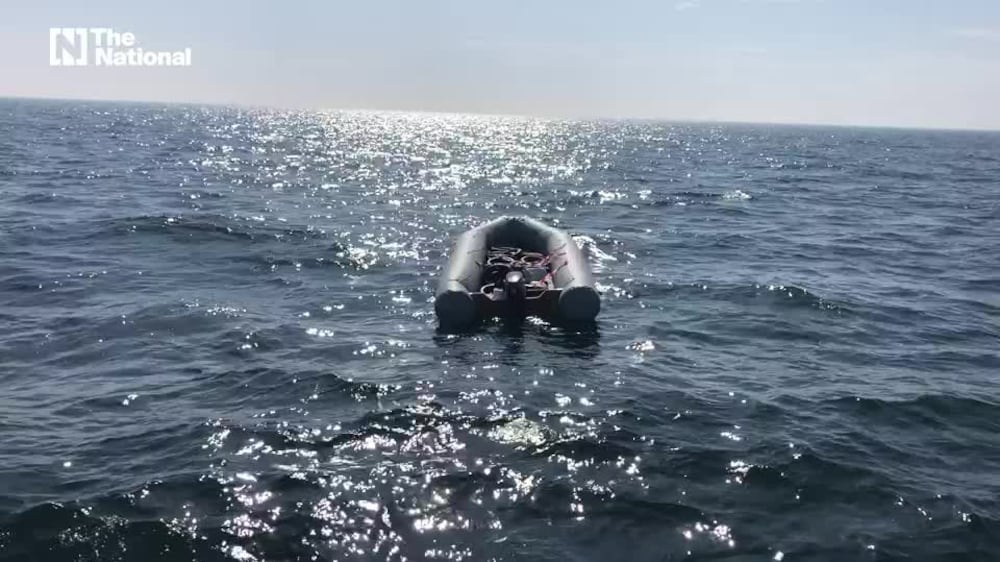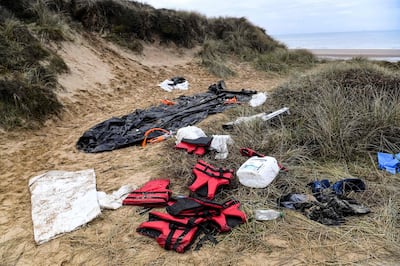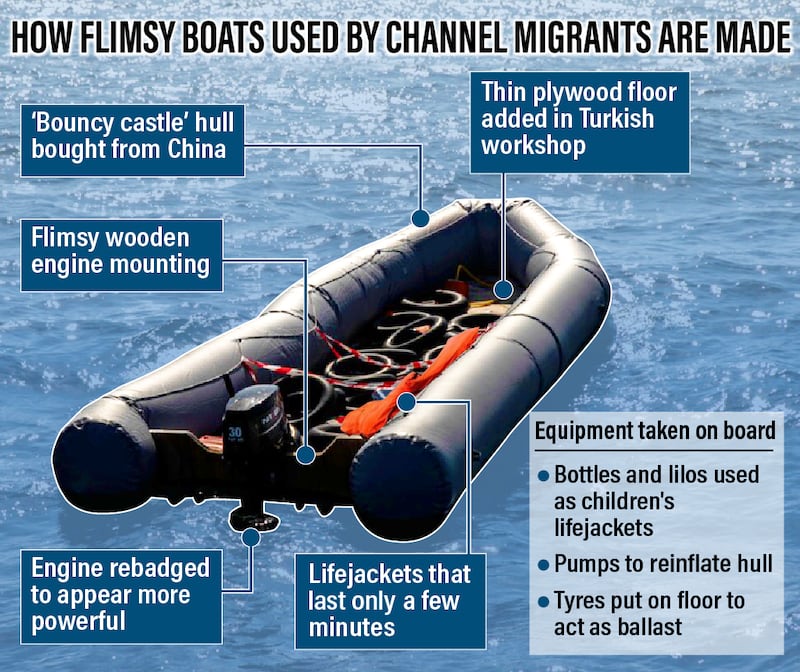When Rafi stepped on to the boat that was to take him across the English Channel, the thought that he would die was a very real one.
The Afghan and his fellow migrants had assembled the flimsy boat on the beach a few minutes earlier and he had been assigned the task of pumping up the hull as others put together the floor and fixed the engine to its mounting.
“I was scared. I didn’t think I would be alive to see the sky and the sea,” the 19-year-old refugee told The National.
He fled from Afghanistan after his parents were killed and, after crossing 11 countries in two years, he embarked across the English Channel in a boat with 28 others.
“The water kept coming into the boat many times. Through the bottom and through the top. We threw the water out by hand. We held the planks so they didn’t come out because they nearly came out.”
Rafi is one of the tens of thousands of migrants who crossed the Channel in boats increasingly made used using cut price materials that guarantee gangs an enormous profit but mean deaths are “inevitable”.
Most of the flimsy vessels are put together in small factories in Turkey using parts sourced in China but gangs can make around €160,000 per trip, an outlay of around €4,700, one expert has said.
By speaking to those with knowledge of the trade and with the help of volunteers, an investigation by The National has built up a picture of the highly organised trade around migrant crossings.
Video taken by rescuers shows one of the flimsy boats with thin plywood floors bobbing around in the English Channel after migrants on board were rescued and taken ashore.
As they sit in flimsy boats crossing the world's busiest shipping lane, some migrant children even have Coke bottles or lilos strapped to them instead of life jackets, sitting on tyres used as ballast, such is the drive to cut costs, The National has learnt.
A record year in 2022 resulted in 45,756 making the treacherous journey, with fears mounting of another crossing disaster to add to the reported death toll of at least 47 since 2019.
'Better run than most businesses'
Rob Lawrie has been researching small boats and the trade that surrounds them for around 10 years.
Mr Lawrie, a former soldier, became involved in helping migrants after learning of the fate of Alan Kurdi, a Syrian boy who drowned in the Mediterranean while attempting to reach Europe from Turkey in 2015.
He shared what he has learnt from his experience in Turkey, Greece, France, Belgium and Germany with The National.
“Governments underestimate the organisational skills of smugglers in a way that makes the public think rough, tough gang,” he said.
“They’re not. They’re highly skilled business people. It’s run better than most legit businesses. It’s quite brilliant. It’s a global institution. They are phenomenal businessmen and women.”
Tony Smith, the former director of the UK border force and now a global border security consultant, described the increasing danger posed by the new type of “hopelessly” overcrowded migrant boats he’s seen.
“I’m really worried we’re going to get more drownings. It’s not unusual to see 50 per boat bobbing along,” said Mr Smith, who’s now the managing director of Fortinus Global, a border management consultancy, told The National.
“The outboard motors are attached to a wooden plank across the back of the dinghy and they’re using pretty cheap plywood which gets wet and can disintegrate quite quickly so the engine can fall off.
“The mood music of the past few months is that the quality of boats has gone down this year compared to last year. The life jackets wouldn’t keep you alive for more than five minutes. All the guys are amazed there haven’t been more boats capsize. It’s terrible.”
Mr Lawrie explains the manufacturing of these boats is done by legitimate boat building firms having what he calls a “tag on business” dedicated to making craft for people smuggling.
The boats they make are between nine and 11 metres long and made with materials sourced from China and payment transferred through the US banking system.
“All my research down the years tells me that I would say 80 to 90 per cent of boats are coming out of Turkey – either made there or bought out of China and sent via Turkey.”
Empty migrant boat seen floating in English Channel

The facilities range from a cellar to a small warehouse where as many as “two to three hundred” boats are ready for shipment.
“One method is to obtain a built boat bought off a Chinese website, but there’s more money to be made for the supplier by buying materials.
“I’ve proven that companies in China are willing to sell me a boat and I’ve actually asked ‘can I use this boat to cross the English Channel’ and the answer, every time, apart from once has been ‘yes, yes’.”
When it comes to the engine he said that it’s “common practice” to remove the 20 horsepower sticker on the engine and replace it with a 40 or 60hp sticker to make the boat appear more powerful and “make it more attractive for the migrants”.
He said of the boats: “They’re substantial if you’re messing about on a lake. Nothing about these boats is designed to cross the Channel.”
Huge profits
The transportation of the boats involves companies, set up with money laundered from people smuggling, providing the paperwork for them to be transported legally across Europe, a journey of about ten days.
“It’s not an illegal activity to manufacture boats and it’s not illegal to transport them either. If I order say 10 boats and want to ship them to France, then 90 per cent of the journey is legal.”
Mr Lawrie revealed he has seen Turkish vans deliver boats into what he describes as “hubs” in Germany reasonably close to Belgium or France, where they can be smuggled across the border to avoid attempts from both countries to clamp down on the trade.
He said a typical order will comprise seven boats and around 300 life jackets for around €33,000 including delivery paid to the boat makers via a Hawala banker.
The smuggling gang will charge around €4000 – €5000 per migrant with as many as 50 packed on to each boat.
German nationals then transport in one of the boats, which when disassembled fit in the boot of a car, to the border.
“The boats will be handed over to another driver, again usually Turkish or Kurdish nationality, and that driver will be given a GPS location about where to place the boat. The boat will be placed on a beach between Dunkirk and Boulogne.
“You will send the signal via WhatsApp or Signal. They are very aware of their digital footprint.”
Rafi revealed what happens when the boat finally arrives on the beach ready to carry migrants across the Channel.

“The boat came from Germany. Someone sent the location to the driver and the driver just came and threw everything there in one minute,” he said.
He explained there were about three or four people who appeared to know how to assemble the boat but they then asked the rest of the group to help.
“The boat came separately and we needed to put it all together,” said Rafi, whose name has been changed to protect his identity.
“They said if you make it quickly then the police will not come. I was pumping. It’s a nine-metre boat so you need to pump it quickly.”
His group then began making their way across the Channel with the steering of the boat entrusted to “one refugee who paid half price”.
After nine hours the refugees made it to the English coast, where they were picked up by the police.
“I was so happy that we had made it. I was feeling alive. I didn’t know how I made it.”
Rafi is being supported by the Refugee and Migrant Forum of Essex and London.

Those who have been at the sharp end of saving the lives of the many migrants who get into trouble also described the ever more dangerous and flimsy boats.
“The lack of safe routes to the UK means refugees have no choice” but to “put their lives at risk crossing the Channel”, said Nick Beales, head of campaigning at Ramfeel.
“Rather than focusing on ever crueller, ineffective and more extreme measures, like their cash for humans Rwanda plan, the government’s priorities should be processing asylum claims in a timely manner,” he said.
This was “so that refugees can actually begin rebuilding their lives and creating safe routes so that dangerous journeys are no longer needed”.
Simon Purkiss, a volunteer with the charity Channel Rescue, also described to The National the condition of the boats he has encountered.
“We’re seeing craft that are less and less seaworthy,” he told The National.
“At first, we were seeing boats that had either been bought very cheaply or had been stolen.
“But what we’ve seen is a move towards craft that seem to be purpose-built for the Channel crossing that carry up to 50 people.”
Disaster was always 'inevitable'
Mr Purkiss said the tubes are made of a “bouncy castle-type material”, and do not have pressure release valves.
“On a commercial boat, or indeed anything other than what you would get for paddling about on holiday, if you pump the air up and it then expands there’s a passage for its release before it blows the seams.”
The type of material used means when the temperature rises, there is no outlet for expanding air, often resulting in the tubes of the vessel bursting.
“Then suddenly you're just sat on a piece of plywood in the English Channel,” he said.
He said that aggressive patrolling of the Calais area by the French police has meant activity has moved farther south, away from Dover towards Dungeness. This means a longer Channel crossing.
Mr Purkiss said there are now reports of migrants having been at sea for 15 hours rather than five or six.
He also made a grim prediction about what the latest trends in crossings will mean.
“The direction is towards bigger and cheaper craft,” he said. “The people who organise the crossings, their only incentive is to get as many people on board as possible with minimum safety.
“The flimsier the craft, the longer the journey, the more the danger. We’re pushing closer and closer to another tragedy. It’s almost inevitable.”

The National Crime Agency has been taking the lead in tackling the supply of boats.
It said “a number” of its 90 investigations into immigration crime or human trafficking related to breaking up the cross-border trade.
These are “targeting groups involved in small-boats criminality, or activity which facilitates it, for example, through the supply of boats and engines or the laundering of profits,” said a representative of the agency.
Given that much of the criminality involved lies outside the UK, the NCA says it is building up intelligence sharing with law enforcement in countries such as France and Belgium.
“We target and disrupt organised crime groups at every step of the route, in source countries, in transit countries such as Greece, Italy and Turkey, near the UK border in France and Belgium, and those operating inside the UK itself,” said the representative.
“This includes having NCA officers based in those countries, sharing intelligence and working side by side on joint investigations.”






